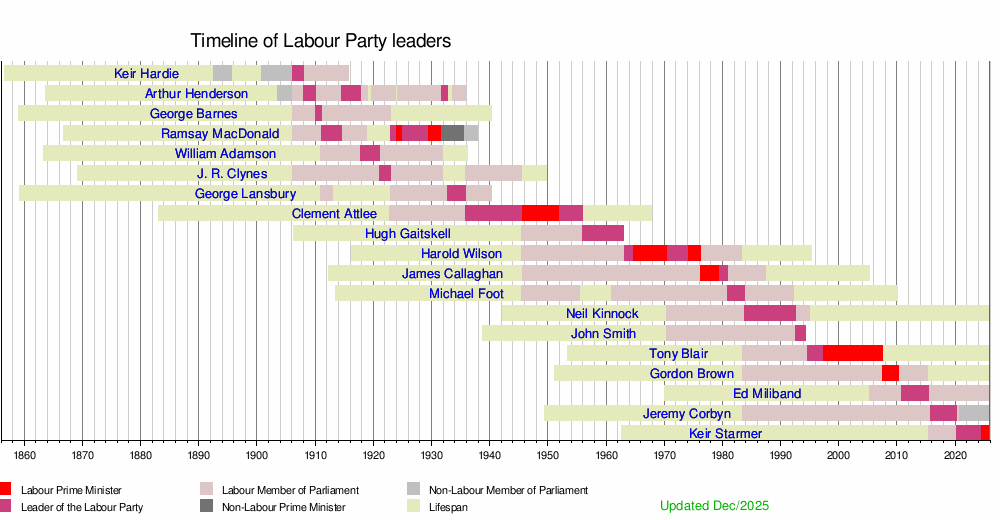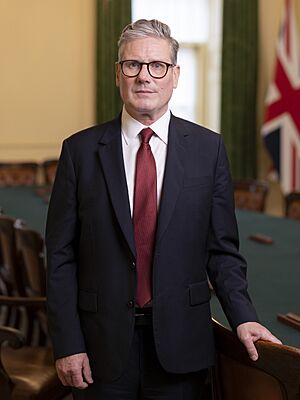Leader of the Labour Party (UK) facts for kids
Quick facts for kids Leader of the Labour Party |
|
|---|---|
| Member of | National Executive Committee |
| Precursor | Chair of the PLP |
| Inaugural holder | Keir Hardie |
| Formation | 17 January 1906 |
| Deputy | Deputy Leader of the Labour Party |
The Leader of the Labour Party is the most important job within the Labour Party in the United Kingdom. This person is like the captain of the team. The current leader is Keir Starmer. He became leader on 4 April 2020. He also became the Prime Minister of the United Kingdom after the 2024 general election.
The official rules for having a leader were written down in 1922. Before that, the leader was called the "Chairman of the Parliamentary Labour Party." This was from when Labour Members of Parliament (MPs) were first elected in 1906. After the 1970 election, the roles of party leader and PLP chairman became separate.
In 1921, J. R. Clynes was the first Labour Party leader born in England. All the leaders before him were born in Scotland. After the 1924 election, Ramsay MacDonald became the first Labour leader to become Prime Minister. He led a government for nine months. Later, in 1945, Clement Attlee was the first leader to win enough seats to form a majority government. In 1983, Neil Kinnock was the first leader born in Wales. Only two leaders, George Lansbury and John Smith, did not lead the party in a general election. George Lansbury resigned, and John Smith sadly died while in office.
So far, only four leaders have won general elections for the Labour Party. These are Clement Attlee, Harold Wilson, Tony Blair, and Keir Starmer. Tony Blair was the most successful. He won three elections in a row: in 1997, 2001, and 2005. The 1997 and 2001 wins were very big, called "landslide victories." Harold Wilson won four out of five elections he fought. He won in 1964, 1966, February 1974, and October 1974. Clement Attlee won in 1945 and 1950. Keir Starmer led Labour to a big win in 2024, after the party had a difficult election in 2019. James Callaghan and Gordon Brown also became Prime Ministers, but they did not win general elections as Labour leaders.
When the Labour Party is in charge of the Government of the United Kingdom, the leader becomes the Prime Minister. They also lead the Cabinet, which is a group of top government ministers. When the party is not in power, the leader becomes the Leader of the Opposition. They lead the Shadow Cabinet, which challenges the government.
Contents
How Labour Leaders Are Chosen
The Leader of the Labour Party, and their deputy, are chosen using a special voting system. It's called an "alternative vote" system. Before 1980, only Labour Members of Parliament (MPs) voted for the leader.
From 1980 to 2014, an "electoral college" was used. This meant votes were split into three equal parts. One-third of the votes came from MPs and Members of the European Parliament (MEPs). Another third came from individual Labour Party members. The final third came from members of groups connected to the Labour Party, like trade unions.
Since the 2015 election, the party uses a "one member, one vote" system. This means that the votes of MPs, party members, and members of connected groups all count equally. Even though MPs' votes are not counted separately anymore, a candidate still needs support from at least 20% of Labour MPs to even be on the ballot.
Labour Party Leaders (1906–Present)
This is a list of all the Labour Party leaders since 1906. It includes people who were acting leaders for a short time.
| No. | Leader (birth–death) |
Constituency | Took office | Left office | Elections fought | Tenure | Prime Minister (term) | ||
|---|---|---|---|---|---|---|---|---|---|
| 1 | Keir Hardie (1856–1915) |
 |
Merthyr Tydfil | 17 January 1906 | 22 January 1908 | 1906 | 2 years, 5 days | Campbell-Bannerman 1905–1908 | |
| 2 | Arthur Henderson (1863–1935) (1st time) |
 |
Barnard Castle | 22 January 1908 | 14 February 1910 | Jan 1910 | 2 years, 24 days | ||
| Asquith 1908–1916 | |||||||||
| 3 | George Barnes (1859–1940) |
 |
Glasgow Blackfriars and Hutchesontown | 14 February 1910 | 6 February 1911 | Dec 1910 | 358 days | ||
| 4 | Ramsay MacDonald (1866–1937) (1st time) |
 |
Leicester | 6 February 1911 | 5 August 1914 | ― | 3 years, 181 days | ||
| (2) | Arthur Henderson (1863–1935) (2nd time) |
 |
Barnard Castle | 5 August 1914 | 24 October 1917 | ― | 3 years, 81 days | ||
| Lloyd George 1916–1922 | |||||||||
| 5 | William Adamson (1863–1936) |
 |
West Fife | 24 October 1917 | 14 February 1921 | 1918 | 3 years, 113 days | ||
| 6 | J. R. Clynes (1869–1949) |
 |
Manchester Platting | 14 February 1921 | 21 November 1922 | 1922 | 1 year, 281 days | ||
| Law 1922–1923 | |||||||||
| (4) | Ramsay MacDonald (1866–1937) (2nd time) |
 |
Aberavon | 21 November 1922 (elected) |
28 August 1931 | 1923
1924 1929 |
8 years, 280 days | ||
| Baldwin 1923–1924 | |||||||||
| Himself 1924 | |||||||||
| Baldwin 1924–1929 | |||||||||
| Himself 1929–1931 | |||||||||
| (2) | Arthur Henderson (1863–1935) (3rd time) |
 |
Burnley (1931) None (1931–1932) |
28 August 1931 (unopposed) |
25 October 1932 | 1931 | 1 year, 59 days | MacDonald 1931–1935 | |
| 7 | George Lansbury (1859–1940) |
 |
Bow and Bromley | 25 October 1932 (unopposed) |
8 October 1935 | ― | 2 years, 349 days | ||
| Baldwin 1935–1937 | |||||||||
| 8 | Clement Attlee (1883–1967) |
 |
Limehouse (1935–1950) Walthamstow West (1950–1955) |
25 October 1935 (elected) |
7 December 1955 | 1935
1945 1950 1951 1955 |
20 years, 44 days | ||
| Chamberlain 1937–1940 | |||||||||
| Churchill 1940–1945 | |||||||||
| Himself 1945–1951 | |||||||||
| Churchill 1951–1955 | |||||||||
| Eden 1955–1957 | |||||||||
| ― | Herbert Morrison (1888–1965) |
 |
Lewisham South | 7 December 1955 | 14 December 1955 | ― | 7 days | ||
| 9 | Hugh Gaitskell (1906–1963) |
 |
Leeds South | 14 December 1955 (elected) |
18 January 1963 (died in office) |
1959 | 7 years, 36 days | ||
| Macmillan 1957–1963 | |||||||||
| ― | George Brown (1914–1985) |
 |
Belper | 18 January 1963 | 14 February 1963 | ― | 28 days | ||
| 10 | Harold Wilson (1916–1995) |
Huyton | 14 February 1963 (elected) |
5 April 1976 | 1964 | 13 years, 50 days | |||
| Douglas-Home 1963–1964 | |||||||||
| Himself 1964–1970 | |||||||||
| Heath 1970–1974 | |||||||||
| Himself 1974–1976 | |||||||||
| 11 | James Callaghan (1912–2005) |
 |
Cardiff South East | 5 April 1976 (elected) |
10 November 1980 | 1979 | 4 years, 221 days | Himself 1976–1979 | |
| Thatcher 1979–1990 | |||||||||
| 12 | Michael Foot (1913–2010) |
 |
Ebbw Vale | 10 November 1980 (elected) |
2 October 1983 | 1983 | 2 years, 327 days | ||
| 13 | Neil Kinnock (b. 1942) |
 |
Islwyn | 2 October 1983 (elected) |
18 July 1992 | 1987 | 8 years, 291 days | ||
| Major 1990–1997 | |||||||||
| 14 | John Smith (1938–1994) |
 |
Monklands East | 18 July 1992 (elected) |
12 May 1994 (died in office) |
― | 1 year, 299 days | ||
| ― | Margaret Beckett (b. 1943) (acting) |
 |
Derby South | 12 May 1994 | 21 July 1994 | ― | 71 days | ||
| 15 | Tony Blair (b. 1953) |
 |
Sedgefield | 21 July 1994 (elected) |
24 June 2007 | 1997 | 12 years, 341 days | ||
| Himself 1997–2007 | |||||||||
| 16 | Gordon Brown (b. 1951) |
 |
Kirkcaldy and Cowdenbeath | 24 June 2007 (unopposed) |
11 May 2010 | 2010 | 2 years, 319 days | Himself 2007–2010 | |
| ― | Harriet Harman (b. 1950) (acting: 1st time) |
 |
Camberwell and Peckham | 11 May 2010 | 25 September 2010 | ― | 138 days | Cameron 2010–2016 | |
| 17 | Ed Miliband (b. 1969) |
 |
Doncaster North | 25 September 2010 (elected) |
8 May 2015 | 2015 | 4 years, 226 days | ||
| ― | Harriet Harman (b. 1950) (acting: 2nd time) |
 |
Camberwell and Peckham | 8 May 2015 | 12 September 2015 | ― | 128 days | ||
| 18 | Jeremy Corbyn (b. 1949) |
 |
Islington North | 12 September 2015 (elected) |
4 April 2020 | 2017 | 4 years, 206 days | ||
| May 2016–2019 | |||||||||
| Johnson 2019–2022 | |||||||||
| 19 | Sir Keir Starmer (b. 1962) |
 |
Holborn and St Pancras | 4 April 2020 (elected) |
Incumbent | 2024 | 5 years, 269 days | ||
| Truss Sep–Oct 2022 | |||||||||
| Sunak 2022–2024 | |||||||||
| Himself 2024–present | |||||||||
Timeline of Labour Party Leaders

Leaders by Time in Office
This list shows how long each Labour Party leader (not including acting leaders) served. Leaders who were also Prime Minister are shown in bold.
| Rank | No. | Leader | Time in office |
|---|---|---|---|
| 1 | 8th | Clement Attlee | 20 years, 44 days |
| 2 | 10th | Harold Wilson | 13 years, 50 days |
| 3 | 15th | Tony Blair | 12 years, 341 days |
| 4 | 4th | Ramsay MacDonald | 12 years, 96 days |
| 5 | 13th | Neil Kinnock | 8 years, 291 days |
| 6 | 9th | Hugh Gaitskell | 7 years, 36 days |
| 7 | 2nd | Arthur Henderson | 6 years, 164 days |
| 8 | 19th | Keir Starmer | 5 years, 269 days |
| 9 | 17th | Ed Miliband | 4 years, 226 days |
| 10 | 11th | James Callaghan | 4 years, 221 days |
| 11 | 18th | Jeremy Corbyn | 4 years, 206 days |
| 12 | 5th | William Adamson | 3 years, 113 days |
| 13 | 7th | George Lansbury | 2 years, 349 days |
| 14 | 12th | Michael Foot | 2 years, 327 days |
| 15 | 16th | Gordon Brown | 2 years, 319 days |
| 16 | 1st | Keir Hardie | 2 years, 5 days |
| 17 | 14th | John Smith | 1 year, 299 days |
| 18 | 6th | J. R. Clynes | 1 year, 281 days |
| 19 | 3rd | George Barnes | 358 days |
Life After Being Leader
When a Labour Party leader retires, especially if they were Prime Minister, they often get a special title called a peerage. This means they can become a member of the House of Lords. Examples include Clement Attlee, Harold Wilson, and James Callaghan. Neil Kinnock also became a member of the House of Lords, even though he was never Prime Minister. However, Michael Foot chose not to accept a similar offer.
More to Explore
- History of the Labour Party (UK)
- Labour Party leadership of Keir Starmer
- Leader of the Conservative Party (UK)
- Leader of the Liberal Democrats



